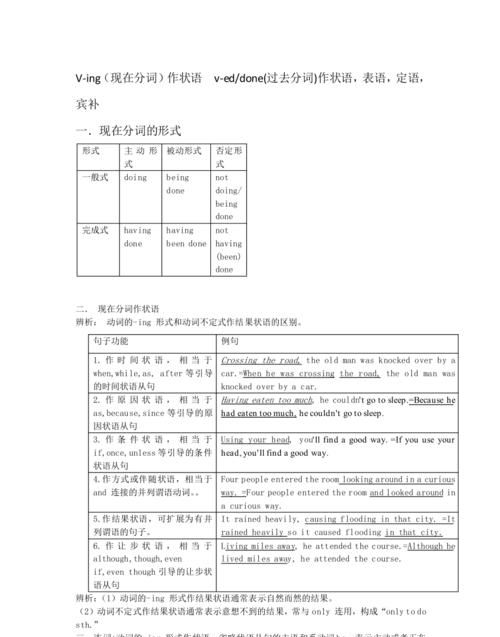本文目录
现在分词是什么意思
一.分词总介:
分词分为现在分词和过去分词两种,是一种非谓语动词形式
现在分词和过去分词主要差别在于:现在分词表示"主动和进行",过去分词表示"被动和完成"(不及物动词的过去分词不表示被动,只表示完成)。分词可以有自己的状语、宾语或逻辑主语等。
1、 分词作状语分词在句子中作状语,可以表示时间、条件、原因、结果、让步、伴随等。
分词(短语)作状语时,其逻辑主语应与句中主语相一致。.当现在分词表示的动作发生在谓语动词之前时, 则用现在分词的完成式,且所表示动作与谓语动作同时发生, 则用现在分词的一般式。完成或被动关系用过去分词。
(1)现在分词The students went out of the classroom, laughing and talking.
(2)过去分词Accompanied by his friend, he went to the railway station. Given better attention, the plants could grow better.
2、"while ( when, once, until, if , though等连词)+分词"结构现在分词或过去分词作状语时,有时可以在分词前加while,when, once, although, until, if等连词。
When leaving the airport, she waved again and again to us. While waiting for the train, I had a long talk with my sister about her work……
Once recovered, he threw himself into his work and made every effort to do it well.
Although working very hard, he failed to pass the final exam. If translated word by word, the passage will be difficult to understand.
3、分词作定语分词作定语时,单个的分词通常放在被修饰的名词之前,分词短语一般置于所修饰的中心词后面。现在分词修饰的是发出该动作的名词(即与名词有主谓关系),过去分词修饰承受该动作的名词(即与名词是动宾关系)。
We will go on with our experiment as soon as we get the added fund.
This is really an exhausting day to all of us!
We can see the part of the moon lighted by sunlight.
After a night spent in excitement and sleeplessness, I forced myself to take a long walk along the beach the next day.
More and more developing countries established strategic partnership with developed countries
4、分词作宾语补足语现在分词在see, watch, hear, observe, notice, feel, find, glimpse, glance等感官动词和look at, listen to等短语动词以及have, keep, get, catch, leave, set, start, send等使役动词后面与名词或代词构成复合宾语,作宾语补语的成分。
5、分词作表语分词作表语通常看作形容词来用。现在分词表示主语的性质,而且主语多为物;过去分词表示主语的感受或状态,主语多为人。
一.现在分词的用法:
1) 做表语:
He was very amused.
That book was rather boring.
很多动词的现在分词都可以作表语:
exciting, interesting, encouraging, disappointing, confusing, touching, puzzling.
2) 作定语:
上面所出现的现在分词都可以用作定语, 修饰一个名词:
That must have been a terrifying experience.
I found him a charming person.
现在分词短语还可以放在名词的后面修饰名词, 相当于一个定语从句:
There are a few boys swimming in the river.
There is a car waiting outside.
3) 作状语:
现在分词短语可以表示一个同时发生的次要的或伴随的动作:
Following Tom, we started to climb the mountain.
Opening the drawer, he took out a box.
Taking a key out of his pocket, he opened the door.
现在分词短语还可以表示原因, 相当于一个原因状语从句:
Not knowing her address, we couldn’t get in touch with her.
Being unemployed, he hasn’t got much money.
现在分词短语还可以表示时间, 相当于一个时间状语从句:
Hearing the news, they all jumped with joy.
Returning home, he began to do his homework.
Jim hurt his arm while playing tennis.
Be careful when crossing the road.
Having found a hotel, we looked for somewhere to have dinner.
Having finished her work, she went home.
4)作宾补:
现在分词在一些动词之后可以做宾语的补语:
例如, see, hear, catch, find, keep , have 等.
I see him passing my house every day.
I caught him stealing things in that shop.
I smelt something burning.
She kept him working all day.
二.过去分词的用法:
1) 作表语:
We were so bored that we couldn’t help yawning.
She felt confused, and even frightened.
They were very pleased with the girl.
I’m satisfied with your answer.
He is not interested in research.
2) 作定语:
She has a pleased look on her face.
The teacher gave us a satisfied smile.
cooked food a written report
fried eggs boiled water
frozen food armed forces
required courses fallen leaves
finished products a forced smile
the risen sun new arrived visitors
What’s the language spoken in that country?
They’re problem left over by history.
The play put on by the teachers was a big success.
Is there anybody injured?
Do you know the number of books ordered?
3)作状语:
Seen from the hill, the city looks magnificent.
Given good health, I hope to finish the work this year.
They came in, followed by some children.
Depressed, he went to see his elder sister.
When treated with kindness, he was very amiable.
4)作宾补:
过去分词也同样可以作宾语的补语, 接在某些动词后面
I will have the clothes washed tomorrow.
When they get back home, they found the room robbed.
[编辑本段]三.巩固练习
1. __________ with the best students, I still have a long way to go.
A. Having compared B. To compare
C. Compared D. Compare
( ) 2. The music of the film _________ by him sounds so ___________ .
A. playing, exciting B. played, excited
C. playing, excited D. played, exciting
( ) 3. __________ against the coming hurricane, they dared not leave home.
A. Warned B. Having warned
C. To warn D. Warn
( ) 4. In __________ countries, you can’t always make yourself _______ by speaking English.
A. English-speaking, understand B. English-spoken, understand
C. English-speaking, understood D. English-spoken, understood
( )5. After _____________ the old man, the doctor suggested that he ___________ a bad cold.
A. examining, should catch B. examined, had caught
C. examining, had caught D. examined, catch
( ) 6. _____________ , Tom jumped into the river and had a good time in it.
A. Be a good swimmer B. Being a good swimmer
C. Having been good swimmer D. To be a good swimmer
( ) 7. ________ how to read the new words, I often look them up in the dictionary.
A. Having not known B. Not to know
C. Don’t know D. Not knowing
( ) 8. As his parent, you shouldn’t have your child ___________ such a book.
A. read B. to read
C. reading D. be reading
( ) 9. He returned from abroad ______________ that his mother had been badly ill.
A. heard B. having been heard
C. having phoned D. having been phoned
答案:
1. C 2. D 3. A 4. C 5. C 6. B 7. D 8. C 9. D

过去分词和现在分词作定语的区别例句
现在分词与过去分词的区别
1)在语法上:现――表示的是主动(表示所修饰人或物的行为);
过――表示的是被动(表示它修饰的人或物是动作承受者)
an exciting story (令人激动的故事)与 excited people(激动的人们)
surprising news 与 a surprised man
2) 在时间上:现――表示正在进行的动作
过――表示已经完成的动作
如:falling snow (正在下的雪) 与 fallen snow (落在地上的雪)
3) 过去分词可以做定语,表示被动;现在分词的被动式也可以作定语,表示被动 不同的是:现――表示正在进行;过――表示已经完成
例句:The bridge being built will be important in this area’s traffic.
The bridge built last year has played an important part in this area’ traffic.
4) 过去分词可以作宾语补足语,表示被动,有时表示已经完成的动作,有时并不表示已经完成;现在分词的被动式也可以作宾语补足语,表示被动,表示正在进行的动作.
例句:He found his wallet stolen.
I’ll have my bike repaired this afternoon.
We found the flat being decorated.

用现在分词和过去分词造句
现在分词例句:1. Going down the street , I met a friend. 我到市区时遇到一个朋友。2. Do you know the man carrying a large umbrella ? 你认识那个拿着一把大雨伞的人吗?3. He went out shutting the door behind him. 他出去后把门随手关上。过去分词例句:1. I got very exhausted,. 我感到精疲力尽。2. United, we stand; divided, we fail. 团结则存,分裂则亡。3. He had his arm broken. 他的手臂摔断了。

英语中现在分词和过去分词用法区别
分词有现在分词和过去分词两种,是一种非谓语动词形式,在句子中不能做谓语。现在分词有时态和语态的变化,而过去分词只有一种形式,现在分词的一般式常表主动和进行,过去分词表示被动,完成。以make 为例,making(一般式) , being made(一般被动式) , having made, (完成式) having been made(完成被动式) 可见,现在分词的形式总共有四种 made(过去分词)过去分词的形式只有这一种。现在分词的完成式,主动和被动,表示分词的动作发生在句子中谓语动词所表示的动作之前,一般在句中做时间或原因状语。例句:Having been made in China years before, the product has a long history.(很多年之前在中国被制造,这个产品有很长的历史了。)在这句话中 ,having been made的动作就发生在谓语动词has 之前,整个分词短语在句中做状语. 过去分词在句中做的成分就比较多了,有表语,定语,状语,补语。例句如下:she is excited(形容词性质的过去分词常作表语);she likes the book written by Lu Xun.(过去分词短语做定语,修饰the book,表示被动,完成,这本书已经被写完了。).Made in my hometown,the product is beautiful.(过去分词短语做状语,但是没有现在分词的完成式那么强调动作发生的先后,此句中状语和谓语的时间是平行的,并列的两个产品的 特征。) she saw him praised by others.(过去分词短语做宾补,表示被动,完成)总之,现在分词完成 被动式只做状语,强调分词的时间先于谓语的时间,通常状语中有很明显的时间状语,before,for 加时间段等在完成时态中常见的时间状语;过去分词可以做四种成分,只有一种形式,done,表示被动 完成,它做状语的时候,不强调时间先后。

以上就是关于过去分词和现在分词的例句,现在分词是什么意思的全部内容,以及过去分词和现在分词的例句 的相关内容,希望能够帮到您。

